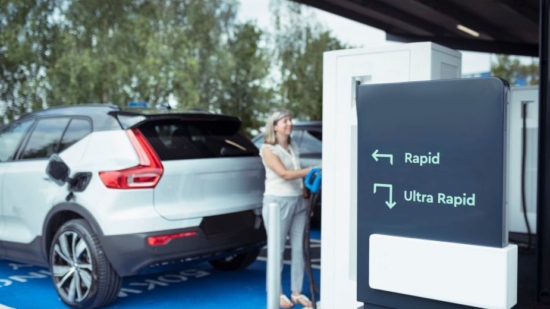Pathway for zero emission vehicle transition by 2035 becomes law
 The government has committed to the transition to electric vehicles, but only 46 out of 119 motorway services reviewed by the RAC (39%) now have the target number of chargers (Photo: RAC)
The government has committed to the transition to electric vehicles, but only 46 out of 119 motorway services reviewed by the RAC (39%) now have the target number of chargers (Photo: RAC)
The UK government’s zero emissions pathway became law 3 January 2024. Technology and Decarbonisation Minister Anthony Browne visited a new bp pulse hub in London to mark the occasion. The zero emission vehicle mandate (ZEV) mandate sets out the percentage of new zero emission cars and vans manufacturers will be required to produce each year up to 2030. 80 per cent of new cars and 70 per cent of new vans sold in Great Britain will now be zero emission by 2030, increasing to 100 per cent by 2035.
Technology and Decarbonisation Minister Anthony Browne said: “Alongside us having spent more than £2 billion in the transition to electric vehicles, our zero emission vehicle mandate will further boost the economy and support manufacturers to safeguard skilled British jobs in the automotive industry.
“We are providing investment certainty for the charging sector to expand our charging network which has already grown by 44 per cent since this time last year. This will support the constantly growing number of EVs in the UK, which currently account for over 16 per cent of the new UK car market.”
The government’s schemes to lower the upfront and running costs of owning an EV include the plug-in van grant of up to £2,500 for small vans and £5,000 for large vans until at least 2025 and £350 off the cost of homeplace chargepoints for people living in flats. Latest statistics show that there has been a 41 per cent increase in zero emission vehicles registered for the first time.
In addition, there are now over 50,000 public chargepoints, with 44 per cent more than this time last year, putting the country well on track to reach 300,000 chargepoints by 2030. “The certainty of the ZEV Mandate will give industry renewed confidence to invest in our infrastructure”, say ministers.
However, a few days earlier motoring association, the RAC reported that “the Government has not hit its target of having six or more rapid or ultra-rapid electric vehicle chargers at every motorway service area in England by the end of 2023”.
46 out of 119 motorway services reviewed by the RAC (39%) on Zapmap now have the target number of chargers above 50kW to serve the UK’s growing fleet of battery-electric vehicles which should have exceeded the 1 million milestone by the end of 2023. he number of rapid chargers has grown from just 27 (23%) at the end of April.
Nevertheless, last month the UK and EU agreed to extend trade rules on electric vehicles, saving manufacturers and consumers up to £4.3 billion in additional costs.
Recent electric vehicle-related investment in the UK include: Nissan’s recent investment of over £3 billion to develop two new electric vehicles at their Sunderland plant, Tata’s investment of over £4 billion in a new 40 GWh gigafactory, BMW’s investment of £600 million to build next generation MINI EVs in Oxford, Ford’s investment of £380 million in Halewood to make Electric Drive Units and Stellantis’ £100 million investment in Ellesmere Port for EV van production.
Andrew Brem, general manager of Uber UK, commented: “London is Uber’s top city for EVs worldwide, with well over 10,000 electric vehicles on the platform in the capital. However, the availability and up-front cost of EVs can still be a barrier for many drivers. The ZEV mandate coming into force is a significant moment which will help to drive down the costs of EVs and increase supply – accelerating the uptake of EVs over the next decade.”




Comments